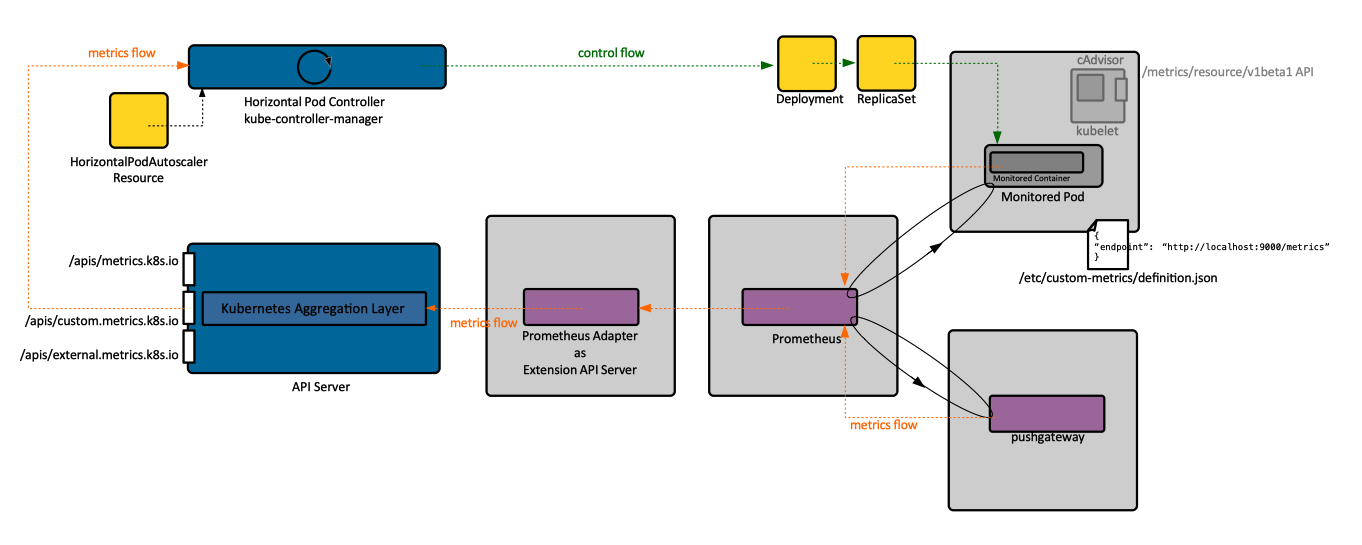Prometheus Adapter for Kubernetes Metrics APIs: Difference between revisions
| Line 29: | Line 29: | ||
- {...} | - {...} | ||
</syntaxhighlight> | </syntaxhighlight> | ||
The discovery step is defined by a "seriesQuery" | The discovery step is defined by a "seriesQuery": | ||
<syntaxhighlight lang='yaml'> | <syntaxhighlight lang='yaml'> | ||
rules: | rules: | ||
- seriesQuery: 'http_requests_total{kubernetes_namespace!="",kubernetes_pod_name!=""}' | - seriesQuery: 'http_requests_total{kubernetes_namespace!="",kubernetes_pod_name!=""}' | ||
</syntaxhighlight> | </syntaxhighlight> | ||
The association step maps labels to known resources. It is introduced by the "resources" keyword, followed by an "overrides" map, where labels are mapped to known resources. | |||
<syntaxhighlight lang='yaml'> | |||
rules: | |||
- seriesQuery: 'http_requests_total{kubernetes_namespace!="",kubernetes_pod_name!=""}' | |||
resources: | |||
overrides: | |||
kubernetes_namespace: {resource: "namespace"} | |||
kubernetes_pod_name: {resource: "pod"} | |||
</syntaxhighlight> | |||
This says that each label represents its corresponding resource. For resources in the "core" kubernetes API the group does not need to be specified. The adapter will handle pluralization, "pod" is equivalent with "pods". The resources can be any resource available in your kubernetes cluster, as long as you've got a corresponding label. | |||
If labels follow a consistent pattern, like "kubernetes_<resource>", the mapping can be done with a | |||
=Helm Installation= | =Helm Installation= | ||
Revision as of 05:30, 15 October 2020
External
- https://github.com/DirectXMan12/k8s-prometheus-adapter
- https://github.com/prometheus-community/helm-charts/tree/main/charts/prometheus-adapter
Internal
Overview
The Prometheus adapter is a Kubernetes Aggregation Layer extension and operates as an extension API server. It knows how to communicate with both Kubernetes and Prometheus, acting as a translator between the two. The API is registered as "custom.metrics.k8s.io/v1beta1".
How it Works
The adapter processes the metrics coming from Prometheus as follows:
Discovery: it discovers available metrics.
Association: it determines which kubernetes resource each metric is associated with.
Naming: it determines how it should expose the metrics in the custom metric API.
Querying: Finally, it figures out how it should query Prometheus to get the actual numbers.
The adapter performs each of the steps for each metric. These steps are formally described for each metric with a rule:
rules:
- {...}
- {...}
The discovery step is defined by a "seriesQuery":
rules:
- seriesQuery: 'http_requests_total{kubernetes_namespace!="",kubernetes_pod_name!=""}'
The association step maps labels to known resources. It is introduced by the "resources" keyword, followed by an "overrides" map, where labels are mapped to known resources.
rules:
- seriesQuery: 'http_requests_total{kubernetes_namespace!="",kubernetes_pod_name!=""}'
resources:
overrides:
kubernetes_namespace: {resource: "namespace"}
kubernetes_pod_name: {resource: "pod"}
This says that each label represents its corresponding resource. For resources in the "core" kubernetes API the group does not need to be specified. The adapter will handle pluralization, "pod" is equivalent with "pods". The resources can be any resource available in your kubernetes cluster, as long as you've got a corresponding label.
If labels follow a consistent pattern, like "kubernetes_<resource>", the mapping can be done with a
Helm Installation
The adapter will be installed in the same namespace as Prometheus.
helm repo add prometheus-community https://prometheus-community.github.io/helm-charts
helm search repo prometheus-community
helm install -n prom prometheus-adapter prometheus-community/prometheus-adapter -f ./prometheus-adapter-overlay.yaml
See Configuration below for prometheus-adapter-overlay.yaml.
Test installation:
kubectl get --raw /apis/custom.metrics.k8s.io/v1beta1 | jq
{
"kind": "APIResourceList",
"apiVersion": "v1",
"groupVersion": "custom.metrics.k8s.io/v1beta1",
"resources": [
{
"name": "jobs.batch/kubernetes_build_info",
"singularName": "",
"namespaced": true,
"kind": "MetricValueList",
"verbs": [
"get"
]
},
{
"name": "services/kube_deployment_spec_strategy_rollingupdate_max_surge",
"singularName": "",
"namespaced": true,
"kind": "MetricValueList",
"verbs": [
"get"
]
},
...
}
Configuration
Use the following prometheus-adapter-overlay.yaml:
helm show values prometheus-community/prometheus-adapter > ~/tmp/prometheus-adapter-overlay.yaml
prometheus:
url: http://prometheus-kube-prometheus-prometheus.prom.svc
Increase log level when installing the chart.
Test:
kubectl get --raw "/apis/custom.metrics.k8s.io/v1beta1/namespaces/default/pods/*/http_requests?selector=app%3Dsample-app"
Configuration Resources:
- Configuration Reference: https://github.com/DirectXMan12/k8s-prometheus-adapter/blob/master/docs/config.md
- Basics of setting the Prometheus Adapter walkthrough (the full walkthrough): https://github.com/DirectXMan12/k8s-prometheus-adapter/blob/master/docs/walkthrough.md
- Configuration walkthrough: https://github.com/DirectXMan12/k8s-prometheus-adapter/blob/master/docs/config-walkthrough.md
- Default configuration: https://github.com/DirectXMan12/k8s-prometheus-adapter/blob/master/deploy/manifests/custom-metrics-config-map.yaml
- Chart README configuration section: https://github.com/prometheus-community/helm-charts/tree/main/charts/prometheus-adapter#configuration
Troubleshooting
tail the logs, Prometheus connection refused is reported there.
